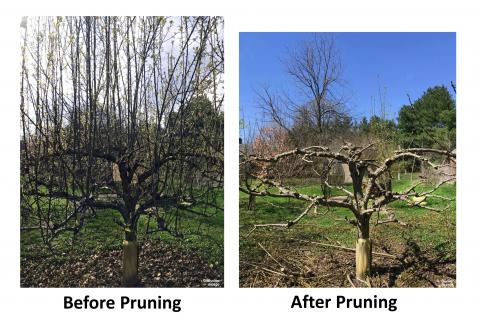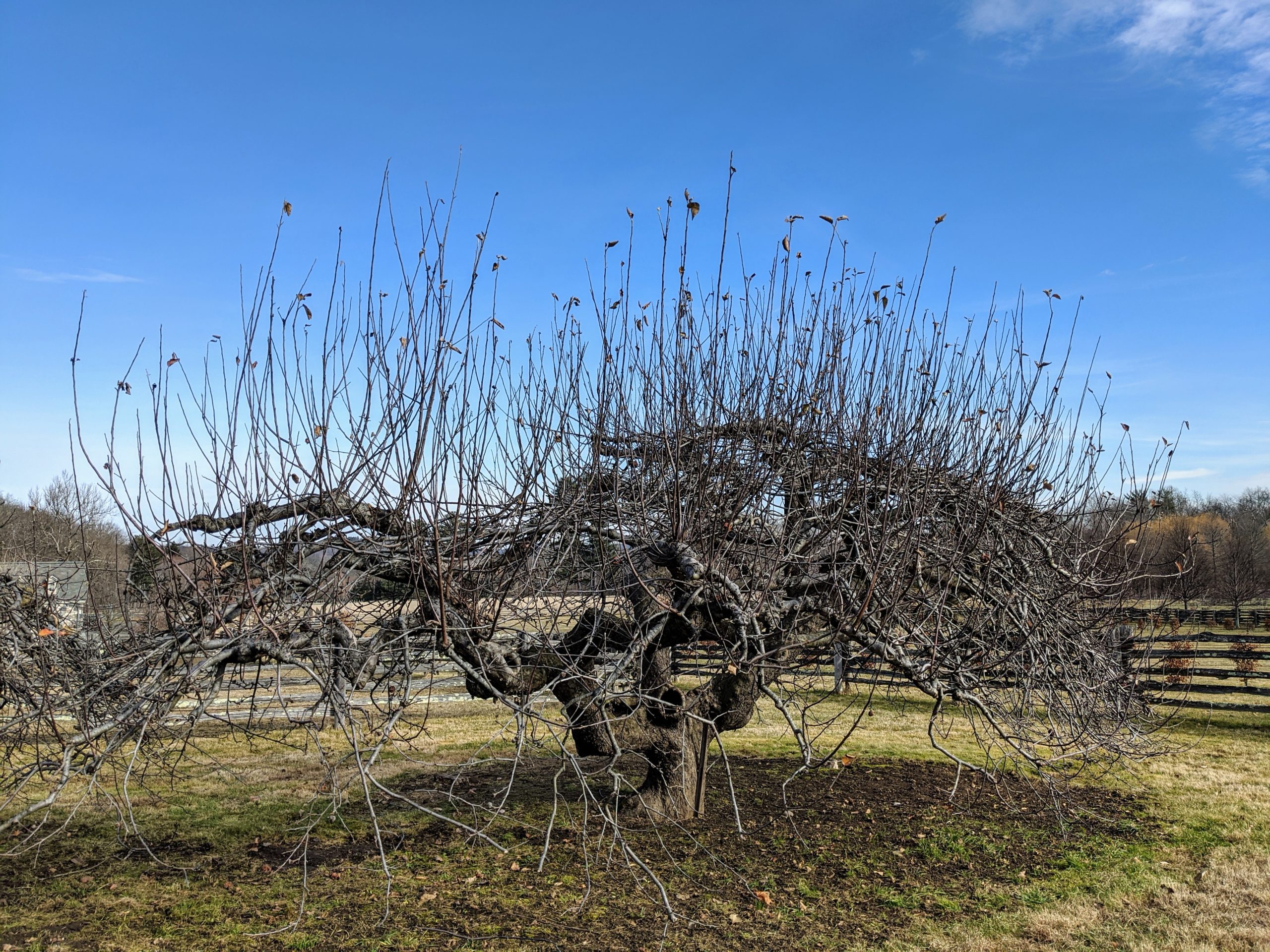To prune apple trees, remove poorly spaced and narrow-angled branches, reducing the length of branches by up to half. For large overgrown apple trees, remove suckers from the base and choose the best scaffold branches, thinning the branches on each scaffold branch.
Pruning should be done in late winter or early spring before new growth starts, in order to promote better airflow and sunlight penetration. Avoid pruning in the summer to prevent excessive growth. Additionally, be sure to cut branches at the collar and use limb spreaders to open up the tree.
Proper pruning techniques will maximize the health and productivity of apple trees.
Credit: www.thespruce.com
When To Prune
Pruning apple trees at the right time is crucial for their health and productivity. The timing of pruning directly impacts the tree’s ability to heal and thrive. By understanding the best time for pruning and considering the timing factors, you can ensure the optimal growth and fruit production of your apple trees.
Best Time For Pruning
The best time to prune apple trees is in late winter or very early spring, before any new growth starts. This timing allows for adequate healing before the growing season. Pruning during this period also helps in shaping the tree and promoting productive growth.
Considerations For Timing
When considering the timing of pruning apple trees, it’s essential to focus on the spur development as apples flower and produce fruit on spurs. Hence, pruning last year’s new growth back every season is vital to maintain the productivity of the tree. Additionally, avoiding pruning during the late spring and summer months is crucial as it can lead to excessive sap loss and susceptibility to diseases.
Credit: extension.illinois.edu
Techniques And Tools
Enhance your apple tree’s health and yield with proper pruning techniques and tools. Maintain a balance of sunlight and airflow by removing unwanted wood and creating a structured tree. Utilize collar cuts and limb spreaders for optimal growth and fruit production.
General Rules And Techniques
When it comes to pruning apple trees, there are a few general rules and techniques to keep in mind. These guidelines will help you maintain the health, shape, and productivity of your apple tree. 1. Start by removing poorly spaced and narrow-angled branches. These branches can obstruct airflow and sunlight, leading to disease and poor fruit production. Remove them completely or shorten their length by up to half to encourage better growth. 2. Take a step back and assess the overall shape and structure of the tree. Look for branches that are crossing or rubbing against each other. These branches can cause damage and should be removed to prevent disease and promote healthy growth. 3. Pay attention to the central leader or main stem of the tree. This is the vertical stem that gives the tree its height. Pruning the central leader properly will help maintain the tree’s shape and allow for proper airflow and sunlight penetration. Make clean cuts just above an outward-facing bud or branch. 4. Thinning branches is an important technique to promote airflow and prevent overcrowding. Remove any small, weak, or damaged branches, as well as branches that grow towards the center of the tree. This will create space for better light penetration and encourage the growth of strong, productive branches.Essential Tools For Pruning
To successfully prune apple trees, you’ll need a few essential tools. These tools will help you make clean and precise cuts, ensuring the health and vitality of your tree. 1. Hand pruners: These are small and handheld pruners that are ideal for cutting small branches and twigs. Look for pruners with sharp blades and comfortable handles for ease of use. 2. Loppers: Loppers have long handles and are designed to cut branches that are thicker than what hand pruners can handle. They provide more leverage and make it easier to reach higher branches. 3. Pruning saw: A pruning saw is useful for cutting branches that are too thick for loppers. Look for a saw with a curved blade, as it will give you better control and help prevent accidental damage to the tree. 4. Leather gloves: Protect your hands with a pair of sturdy leather gloves. They will provide protection from sharp thorns, rough bark, and potential cuts. 5. Disinfectant: Keeping your tools clean and disinfected is essential to prevent the spread of diseases. Use a disinfectant spray or wipe to clean your tools before and after each use. Having these tools on hand will make your pruning tasks easier and more efficient. Remember to always make clean and precise cuts and to regularly clean and disinfect your tools to ensure the health of your apple tree. By following these general rules and techniques and using the right tools, you’ll be able to prune your apple tree effectively and promote its growth and productivity. Remember to always prune during the appropriate time of year, usually in late winter or early spring, before new growth starts. With proper pruning, you’ll enjoy healthier and more abundant apple harvests for years to come.Pruning Steps
To properly prune apple trees, start by removing sucker growth and broken branches. Trim branches while cutting at the collar for optimal growth and ventilation. Thinning branches and shaping the tree allow better sunlight penetration and fruit production, ensuring a healthy and flourishing apple tree.
Pruning Young Apple Trees
When it comes to pruning young apple trees, there are a few important steps to follow. First, it’s crucial to remove poorly spaced and narrow-angled branches. By doing this, you’ll ensure that the tree has a strong structure and can support the weight of future fruit. Additionally, branches that are left on the tree should be reduced by up to one-half their length. This will help promote more balanced growth and prevent the tree from becoming top-heavy.
Pruning Older Apple Trees
Pruning older apple trees is slightly different from pruning young ones. To maintain the health and productivity of older trees, it’s important to remove suckers from the base of the tree. Suckers are fast-growing shoots that can sap the energy and nutrients from the main tree. Next, choose approximately six of the best branches to keep as scaffold branches. These branches provide the framework and structure for the tree. Remove all other branches to allow for better airflow and sunlight penetration. Lastly, thin the branches on each scaffold branch to promote optimal fruiting and prevent overcrowding.
Addressing Overgrown Apple Trees
If you have an overgrown apple tree that needs pruning, don’t worry. There are steps you can take to restore its health and shape. Begin by removing suckers from the base of the tree. These shoots can divert energy away from the main tree and hinder its growth. Next, select a few of the strongest and healthiest branches to keep as scaffold branches. Remove any other branches that are crossing or rubbing against each other. Finally, thin the branches on each scaffold branch to maintain an open and balanced structure.
Common Mistakes To Avoid
Pruning apple trees is essential for their health and productivity, but some common mistakes can hinder the process. By being aware of these errors, you can ensure that your apple tree pruning efforts yield positive results.
Pruning Errors To Steer Clear Of
One common mistake is not using the proper tools for pruning. Using dull or incorrect tools can result in jagged cuts, which increases the risk of disease and slows down the tree’s healing. Another error is removing too many branches at once, which can stress the tree and limit its fruiting potential. Additionally, cutting branches too close or too far from the trunk can lead to improper healing and vulnerability to pathogens.
Furthermore, a significant mistake to avoid is neglecting to remove suckers and water sprouts, which can sap the tree’s energy and hinder fruit production. Lastly, failure to consider the tree’s natural growth habits and pruning against its natural form can impact its overall health and fruit-bearing capacity.
Consequences Of Improper Pruning
Improper pruning can have various consequences. It can lead to the development of weak branch structures, making the tree more susceptible to damage from wind, snow, or the weight of fruit. Over-pruning can also result in excessive vegetative growth at the expense of fruit production, impacting the tree’s overall yield. Furthermore, improper pruning techniques can create entry points for pests and diseases, jeopardizing the tree’s health.
Credit: www.themarthablog.com
Frequently Asked Questions On How To Prune Apple Trees
What Is The Best Month To Prune Apple Trees?
The best time to prune apple trees is in late winter or very early spring before new growth starts. It’s essential to prune last year’s new growth back every season. Pruning in March is generally the most suitable month.
How Do You Prune An Apple Tree Step By Step?
To prune an apple tree step by step, follow these guidelines: 1. Remove poorly spaced and narrow-angled branches. 2. Reduce branches on the tree by up to one-half of their length. 3. Remove suckers from the base of the tree. 4.
Choose and keep six of the best branches as scaffold branches. 5. Thin the branches on each scaffold branch. Remember to prune in late winter or early spring before new growth starts.
What Not To Do When Pruning Apple Trees?
When pruning apple trees, avoid these mistakes: 1. Pruning in the wrong season, such as during the summer or fall. 2. Removing too many branches or cutting them too short. 3. Failing to remove suckers and water sprouts from the base of the tree.
4. Not thinning out the branches to allow for better airflow and sunlight penetration. 5. Neglecting to make proper cuts at the collar of the branch.
How Do You Prune A Large Overgrown Apple Tree?
To prune a large overgrown apple tree, remove suckers, select six best scaffold branches, thin branches on each scaffold. Cut back to half their length, ensuring proper spacing. Prune during late winter or very early spring for best results. Use limb spreaders to maintain an open tree structure.
Conclusion
Pruning apple trees is essential for their health and fruitful growth. By following the proper techniques and timing, you can ensure the longevity and productivity of your apple trees. Take the time to learn the best practices and invest in the right tools to maintain your trees’ well-being throughout the year.

